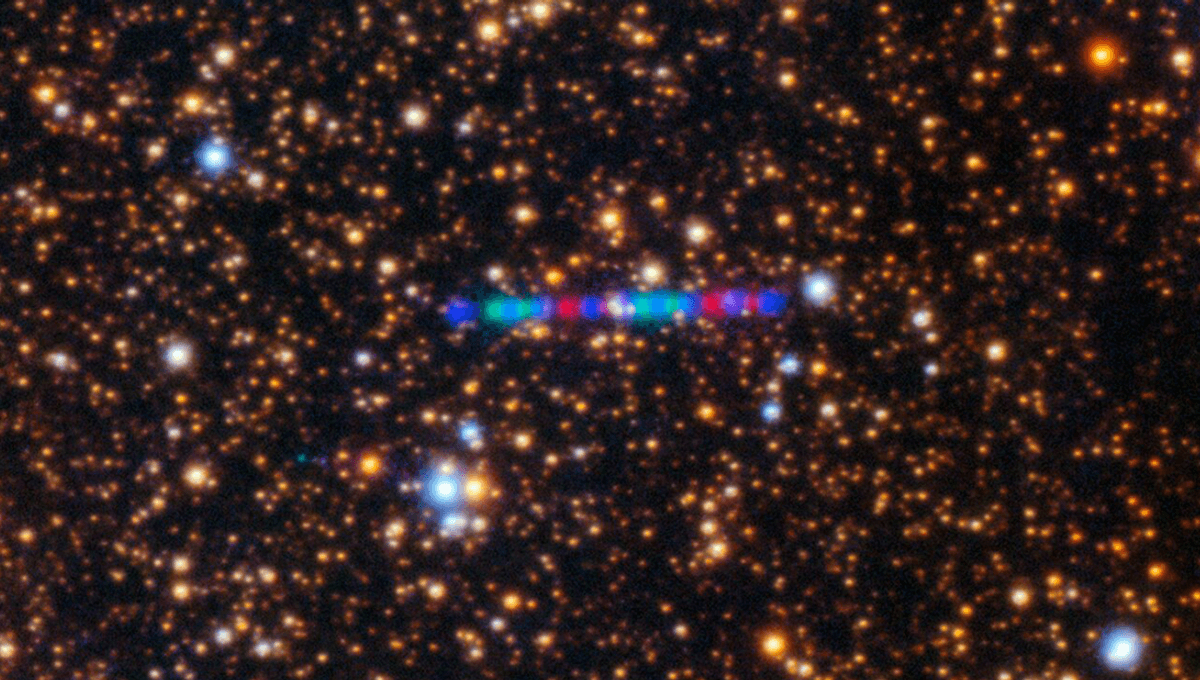
A new study has attempted to pin down the properties of interstellar comet 3I/Atlas, finding it is “anomalously massive” at around 33 billion tons.
On July 1, 2025, astronomers spotted an object moving through the Solar System at nearly twice the velocity of previous interstellar visitors ‘Oumuamua and Comet Borisov. The object, which was confirmed to be an interstellar comet with its own dusty coma, and suspected to be far larger than the previous two, with a then-estimated nucleus (the rocky part of the comet, excluding its coma) of around 5.6 kilometers (3.5 miles).
Sizing comets is a tricky business, primarily because to do so, you need to distinguish the comet from its coma. As comets approach the Sun in their orbit and heat up, they outgas, losing gas and later (when they are even closer to the Sun) dust, which forms their distinctive trail or coma. This outgassing acts like a thruster, slightly altering the trajectory, rotation, and speed of the comet.
That can complicate measurements, but it can also provide key clues. In a new paper, which has not yet been peer reviewed, from Harvard’s Richard Cloete, Avi Loeb, and Peter Vereš, the team looked at data compiled by the Minor Planet Center between May 15 and September 23, 2025, from 227 observatories around the world, and compared the object’s trajectory to what we would expect from gravitational acceleration alone (i.e. acceleration caused by the Sun’s mass as it approaches closer).
The team’s paper found that the non-gravitational acceleration was pretty small, at below 15 meters per day squared. That’s pretty tiny, considering that we have already seen significant outgassing by the comet, including using the JWST, with a mass loss rate of around 150 kilograms (330 pounds) per second. To this team crunching the numbers, that suggests that the object’s nucleus is massive, resisting change to acceleration as the Sun-facing side outgasses.
The team estimates that the object weighs over 33 billion tons – or 33 trillion kilograms – with a nucleus diameter of 5 kilometers (3.1 miles). This is large for a comet, yes, but at 500 trillion tons, or 5×1017 kilograms (500 quadrillion kilograms), C/2014 UN271 (Bernardinelli-Bernstein) still has it beat. But then again, it has the largest comet nucleus ever seen at 128 kilometers (80 miles) across.
So, where is the anomaly? According to Loeb, the mystery is why we haven’t spotted many more interstellar objects before we spotted one of this size.
“3I/ATLAS is more massive than the other two interstellar objects, 1I/`Oumuamua and 2I/Borisov by 3–5 orders of magnitude, constituting a major anomaly,” Loeb said in a blog post. “Given the limited reservoir of heavy elements, we should have discovered on the order of a hundred thousand interstellar objects on the 0.1-kilometer scale of 1I/`Oumuamua before finding 3I/ATLAS, yet we only detected two interstellar objects previously.”
That’s certainly intriguing, if the comet is confirmed to be of this size. Loeb, as he is known to do, once again proposed the (highly unlikely) possibility that it may be an alien spacecraft.
“The mass of 3I/ATLAS scales with its diameter cubed. If the nucleus diameter of 3I/ATLAS will be found to be larger than 5 kilometers in the HiRISE image, then an origin associated with the interstellar mass reservoir of rocky material will be untenable,” he added. “An alternative technological origin could explain the rare alignment of the trajectory of 3I/ATLAS with the ecliptic plane (having a random chance of 1 in 500, as discussed here), and the detection of nickel without iron — as found in industrially-manufactured alloys.”
These claims, as NASA has pointed out, shouldn’t be taken too seriously, with Loeb himself calling it a “pedagogical exercise” in his first paper suggesting it.
“It looks like a comet. It does comet things. It very, very strongly resembles, in just about every way, the comets that we know,” Tom Statler, NASA’s lead scientist for Solar System small bodies, told The Guardian, responding to the claims.
“It has some interesting properties that are a little bit different from our solar system comets, but it behaves like a comet. And so the evidence is overwhelmingly pointing to this object being a natural body. It’s a comet.”
Nevertheless, it would be interesting if 3I/Atlas were much more massive than the other spotted interstellar visitors, and this work suggests it could be.
We should be able to get a better look at the object as it approaches, with the potential to observe it using the HiRISE camera onboard the Mars Reconnaissance Orbiter on October 3, 2025. Frustratingly, it will be on the other side of the Sun during closest approach and will disappear from view, popping back up again in December.
Additionally, we now have the Vera C. Rubin Observatory up and running. Until 2025, astronomers have found around 20,000 new asteroids per year, but when the observatory began working, it found 2,104 new asteroids in just 10 hours of observations. With more data, and hopefully more interstellar objects to look at, we may be able to place more constraints on this puzzling object, and others like it.
The paper is posted to Harvard’s website.
Source Link: "Major Anomaly" As Interstellar Object 3I/Atlas Measured To Be Over 33 Billion Tons